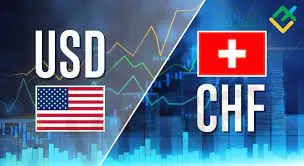简体中文
繁體中文
English
Pусский
日本語
ภาษาไทย
Tiếng Việt
Bahasa Indonesia
Español
हिन्दी
Filippiiniläinen
Français
Deutsch
Português
Türkçe
한국어
العربية
USD/CHF remains pressured around monthly low after declining the most in three weeks.
Abstract:The Swiss currency (CHF) pair dropped the most in three weeks on Monday amid a broad risk-off mood. However, an upward sloping trend line from January 13 restricts the quotes immediate downside near 0.9155.

Bearish MACD signals, sustained trading below the key DMAs keep sellers hopeful.
Sellers can aim for ascending support line from June 2021 on breaking 0.9155.
USD/CHF holds onto the previous day‘s bearish bias around 0.9160-55 heading into Tuesday’s European session.
It should be noted, however, that the bearish MACD signals join the pairs successful trading below the 50-DMA and 200-DMA, to favor sellers targeting an eight-month-old support line near 0.9120.
In a case where USD/CHF drops below 0.9120, the 2022 bottom surrounding 0.9090 will be in focus.
On the flip side, corrective pullback needs validation from the 200-DMA level of 0.9180 before directing buyers towards the 50-DMA, close to 0.9200 by the press time.
Should USD/CHF rally beyond 0.9200, a downward sloping resistance line from January 31, around 0.9250, may lure the pair buyers.
USD/CHF: Daily chart

Disclaimer:
The views in this article only represent the author's personal views, and do not constitute investment advice on this platform. This platform does not guarantee the accuracy, completeness and timeliness of the information in the article, and will not be liable for any loss caused by the use of or reliance on the information in the article.
Read more

Will the Euro and US Dollar Reach Parity in 2025?
Euro-dollar parity sparks debate again as 2025 approaches, with multiple factors shaping the exchange rate outlook.

US Dollar Surge Dominates Forex Market
The global forex market continues to show volatility, with the U.S. dollar fluctuating last week but overall maintaining a strong upward trend. How long can this momentum last?

Oil Prices Soar for 5 Days: How Long Will It Last?
Last week, the global oil market saw a strong performance, with Brent crude and WTI crude prices rising by 2.4% and around 5% respectively. Oil prices have now posted five consecutive days of gains. But how long can this rally last?

How Big is the Impact of the USD-JPY Rate Gap on the Yen?
The U.S. Federal Reserve's repeated rate cuts and the narrowing of the U.S.-Japan interest rate differential are now in sight. So, why is the U.S.-Japan interest rate differential so important for the yen’s safe-haven appeal, especially when global economic uncertainty rises?
WikiFX Broker
Latest News
SQUARED FINANCIAL: Your Friend or Foe?
Big News! UK 30-Year Bond Yields Soar to 25-Year High!
High-Potential Investments: Top 10 Stocks to Watch in 2025
Why Is Nvidia Making Headlines Everywhere Today?
Discover How Your Trading Personality Shapes Success
US Dollar Insights: Key FX Trends You Need to Know
FINRA Charges UBS $1.1 Million for a Decade of False Trade Confirmations
BI Apprehends Japanese Scam Leader in Manila
Bitcoin in 2025: The Opportunities and Challenges Ahead
Join the Event & Level Up Your Forex Journey
Currency Calculator






